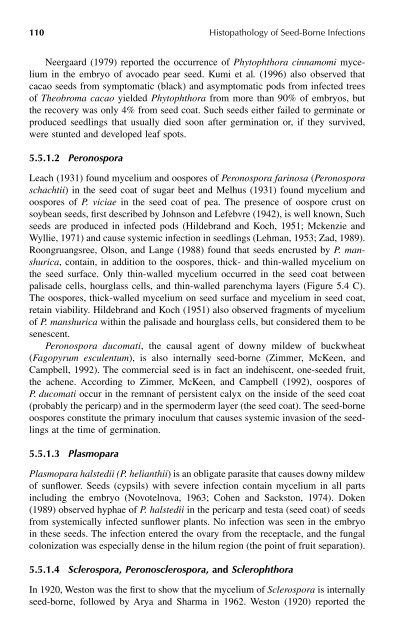Histopathology of Seed-Borne Infections - Applied Research Center ...
Histopathology of Seed-Borne Infections - Applied Research Center ...
Histopathology of Seed-Borne Infections - Applied Research Center ...
Create successful ePaper yourself
Turn your PDF publications into a flip-book with our unique Google optimized e-Paper software.
110 <strong>Histopathology</strong> <strong>of</strong> <strong>Seed</strong>-<strong>Borne</strong> <strong>Infections</strong>Neergaard (1979) reported the occurrence <strong>of</strong> Phytophthora cinnamomi myceliumin the embryo <strong>of</strong> avocado pear seed. Kumi et al. (1996) also observed thatcacao seeds from symptomatic (black) and asymptomatic pods from infected trees<strong>of</strong> Theobroma cacao yielded Phytophthora from more than 90% <strong>of</strong> embryos, butthe recovery was only 4% from seed coat. Such seeds either failed to germinate orproduced seedlings that usually died soon after germination or, if they survived,were stunted and developed leaf spots.5.5.1.2 PeronosporaLeach (1931) found mycelium and oospores <strong>of</strong> Peronospora farinosa (Peronosporaschachtii) in the seed coat <strong>of</strong> sugar beet and Melhus (1931) found mycelium andoospores <strong>of</strong> P. viciae in the seed coat <strong>of</strong> pea. The presence <strong>of</strong> oospore crust onsoybean seeds, first described by Johnson and Lefebvre (1942), is well known, Suchseeds are produced in infected pods (Hildebrand and Koch, 1951; Mckenzie andWyllie, 1971) and cause systemic infection in seedlings (Lehman, 1953; Zad, 1989).Roongruangsree, Olson, and Lange (1988) found that seeds encrusted by P. manshurica,contain, in addition to the oospores, thick- and thin-walled mycelium onthe seed surface. Only thin-walled mycelium occurred in the seed coat betweenpalisade cells, hourglass cells, and thin-walled parenchyma layers (Figure 5.4 C).The oospores, thick-walled mycelium on seed surface and mycelium in seed coat,retain viability. Hildebrand and Koch (1951) also observed fragments <strong>of</strong> mycelium<strong>of</strong> P. manshurica within the palisade and hourglass cells, but considered them to besenescent.Peronospora ducomati, the causal agent <strong>of</strong> downy mildew <strong>of</strong> buckwheat(Fagopyrum esculentum), is also internally seed-borne (Zimmer, McKeen, andCampbell, 1992). The commercial seed is in fact an indehiscent, one-seeded fruit,the achene. According to Zimmer, McKeen, and Campbell (1992), oospores <strong>of</strong>P. ducomati occur in the remnant <strong>of</strong> persistent calyx on the inside <strong>of</strong> the seed coat(probably the pericarp) and in the spermoderm layer (the seed coat). The seed-borneoospores constitute the primary inoculum that causes systemic invasion <strong>of</strong> the seedlingsat the time <strong>of</strong> germination.5.5.1.3 PlasmoparaPlasmopara halstedii (P. helianthii) is an obligate parasite that causes downy mildew<strong>of</strong> sunflower. <strong>Seed</strong>s (cypsils) with severe infection contain mycelium in all partsincluding the embryo (Novotelnova, 1963; Cohen and Sackston, 1974). Doken(1989) observed hyphae <strong>of</strong> P. halstedii in the pericarp and testa (seed coat) <strong>of</strong> seedsfrom systemically infected sunflower plants. No infection was seen in the embryoin these seeds. The infection entered the ovary from the receptacle, and the fungalcolonization was especially dense in the hilum region (the point <strong>of</strong> fruit separation).5.5.1.4 Sclerospora, Peronosclerospora, and SclerophthoraIn 1920, Weston was the first to show that the mycelium <strong>of</strong> Sclerospora is internallyseed-borne, followed by Arya and Sharma in 1962. Weston (1920) reported the


